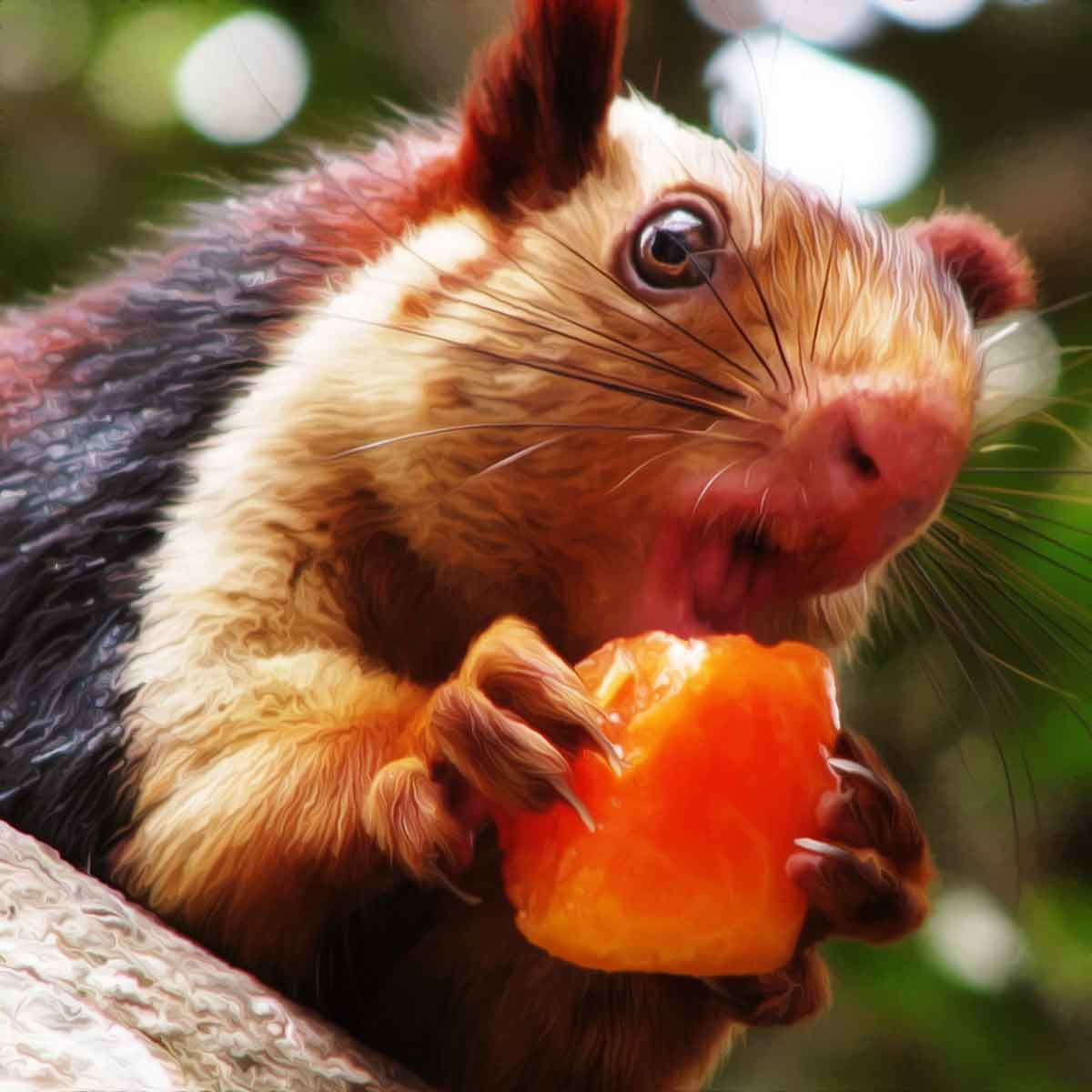More Coverage
Twitter Coverage
Satyaagrah
Written on
Satyaagrah
Written on
Satyaagrah
Written on
Satyaagrah
Written on
Satyaagrah
Written on
JOIN SATYAAGRAH SOCIAL MEDIA
"Look deep into nature, then you will understand everything better": Malabar giant squirrel (also known as shekru), an all-natural technicolor coat endemic to India, stretch as much as 3 feet long—longer than eastern gray squirrel & svelter counterparts

"Look deep into nature, then you will understand everything better": Malabar giant squirrel (also known as shekru), an all-natural technicolor coat endemic to India, stretch as much as 3 feet long—longer than eastern gray squirrel & svelter counterparts
IF YOU’RE PASSING BELOW A thick tree canopy in peninsular India and happen to hear a scurrying above you, be sure to look up. You might catch a glimpse of a striking squirrel whose fur appears to have been hand-painted with splashes of brown, orange, maroon, and black.
|
Meet the Malabar giant squirrel, which boasts an all-natural technicolor coat. Also known as shekru, these bright, bushy beauties, which are endemic to India, stretch as much as three feet long—much longer than the eastern gray squirrel and other svelter counterparts.
The patchwork fur may help the squirrels hide up in the sun-speckled canopy, which would be an advantage, because they spend most of their lives up there, scampering among the branches and nibbling on flowers, bark, seeds, insects, and bird eggs. Their feathery, charcoal-colored tails help them balance while they teeter on narrow branches or hang straight down to feast. High above the forest floor, they’re out of many predators’ reach—but if they are startled, though (say, by one of their winged predators, like the crested serpent eagle), they plop down flush against the branches, as though trying to melt into them.
The cute critter is the state animal of Maharashtra—and if you’re setting out to spot some, your best bet will be in that region’s Bhimashankar Wildlife Sanctuary, tucked among the green, rolling Western Ghats mountain range.
The site is also home to one of India’s 12 jyortirlingas, or shrines, dedicated to the god Shiva. Devotees often flock to the temple during monsoon season—an especially wild time to trek through hills tangled with dense, fog-cloaked forests, and dip a toe into the pools at the base of waterfalls.
The sanctuary was established in the 1980s and has seen the squirrel population grow since. The animals have popped up on endangered species lists, but a census of the furry residents found that their numbers climbed by eight percent in the sanctuary between 2015 and 2016. Researchers surveyed squirrel nests in the nearby mango, coconut palm, and jamun trees and estimated that there were 2,145 individuals bedding down in the branches there. Each squirrel may build as many as eight nests; in 2017, the sanctuary’s census counts more than 22,000 of them.
As an extra boost to the animal’s numbers in the wild, the Rajiv Gandhi Zoological Park and Research Centre launched a breeding effort in July 2018. Soon, there may be more of these colorful creatures than ever.
|
How preserving forests could save the Indian giant squirrel
- Among the four global giant squirrels, the Indian giant squirrel is endemic to India.
- It plays an essential role in balancing the forest’s ecological systems by aiding in seed dispersal. It is also an indicator species, and its presence is indicative of a healthy forest.
- Its numbers are on the decline though, which is why the conservation of IGS needs a holistic approach where the focus is on habitat conservation, identification and protection of specific trees which are preferred by IGS, prevention of habitat fragmentation and reduction of human interference.
Its call is hard to miss. A series of high-pitched and staccato chirrups reverberate through the dense forests where it is found. Follow the sound and you might spot the Indian giant squirrel (IGS) on the tall branches of trees in the deciduous, mixed deciduous or moist evergreen forests of India. Its wide distribution within its range explains why the IGS is listed in the Least Concern category of the IUCN Red List.
But things are not going so well for this giant among squirrels. Hunting and loss of habitat due to deforestation and degradation have forced the species to the brink of local extinction in some areas. “The IGS occurs in severely fragmented populations. So, no population-wise data is available. However, studies indicate that its density in south India ranges from 2.37 squirrels/km2 to 12.26 squirrels/km2 depending on the different protected areas,” says Dhriti Banerjee, Director, Zoological Survey of India.
Size matters
Among the four global giant squirrels, three are found in India – the Indian giant squirrel (Ratufa indica), the black giant squirrel (Ratufa bicolor) and the grizzled giant squirrel (Ratufa macroura). Of these, only the IGS (or the Malabar giant squirrel) is endemic to India. It can be found across the Western Ghats, parts of the Eastern Ghats and the Satpura ranges. It is also the state animal of Maharashtra, where it is called shekru in Marathi.
The IGS has a body length that varies from 254 to 457 mm. The length of its tail is approximately the same as the length of its body. Each squirrel weighs approximately 1.5 to 2 kg. But it’s not just its size that is impressive. The mammal can exhibit different colour patterns with shades of black, brown and deep red being the most predominant.
What’s also interesting is that the fur of the IGS varies according to where it occurs, and from one individual to another even in the same location. For example, those found in the southernmost parts of India are darker, with a lot of black fur on their backs. The same ones won’t be found in Maharashtra. But even in Maharashtra, two individuals at the same site could have different colourings.
|
Life in the air
The IGS is built for life in the trees. It has large, powerful claws that can be used to grip barks and branches. An acrobatic climber, it will often hang by its hindlegs and use its tail for balance while feeding.
Naturally shy and wary, this species rarely descends from the forest canopy. Therefore, it favours habitats with contiguous forest patches, tall trees, and canopy connectivity that protect it from predators and provide an ample supply of food. Yet, despite its high perch, the IGS serves as prey for raptors and sometimes even large carnivores such as leopards and primates.
The giant squirrel is endowed with two front teeth that grow throughout their lives. It primarily feeds on fruits, flowers, seeds, leaves, bark, and occasionally on insects and bird eggs. “The IGS shares a characteristic of rodents: nibbling. It will nibble on tree barks and hard kernels of nuts, which is also a natural mechanism to prevent overgrowth of teeth,” says Nivedita Pande, who has recently co-authored a book on the dental management of captive-born IGS.
Role in the ecosystem
The IGS plays a vital role in balancing the forest’s ecological systems by aiding in seed dispersal. This helps the forest grow and thrive, thus indirectly supporting the local wildlife population and reducing the human-wildlife conflict to a large extent. It is also an indicator species, and its presence is indicative of a healthy forest.
“It needs dense forest canopy and tall trees to thrive. But while forest cover may have increased as per the Status of Forest Report 2021, the quality of forests has reduced. Dense forests, for example, have become less dense. A disturbed or fragmented forest tends to have an immediate impact on this particular species’ numbers,” says Anish Andheria, president, Wildlife Conservation Trust, who has worked extensively on the conservation of the IGS in Maharashtra.
Solitary by nature, the IGS is typically seen in pairs only during the breeding season. It usually constructs more than one nest at a time, which is made of leaves and twigs. These nests are built in tall, profusely branched trees mostly along rivers and streams. The female gives birth to multiple young ones, though often only one reaches adulthood.
Challenges and threats
Being an arboreal species, the IGS needs access to a wide area of trees offering fruits, insects and barks as well as breeding opportunities. Habitat destruction, habitat alteration like fragmentation, the building of roads and laying of power lines, and cutting of old and tall trees have a negative impact on its population. Also, squirrels that do come down to the ground, especially if there is no canopy cover, often become roadkill.
“It is completely forest dependent (unlike palm squirrels which live in modified habitats) and does not tolerate habitat degradation. It is what is causing a decline in their numbers. Poaching, especially in the Eastern Ghats where new human settlements have been built, is also a threat to this species,” says Banerjee of ZSI.
Born free
Another concern is that these giant squirrels are notoriously difficult to breed in captivity. For one, their natural habitat must be replicated as far as possible, and the reclusive animals need to be protected from disturbance.
“The IGS is a very active species. Captive breeding programmes typically have smaller areas as compared to the wilderness, so they may be deleterious to their overall habit of jumping between tall trees. Lack of a complete diet, which it generally feeds on in the wild, also tends to be overlooked in captivity. It, at times, is only presented with soft foods, which is in conflict with its natural behaviour of nibbling. Additionally, high sugar content in a diet that primarily revolves around fruits leads to dental caries – just like in humans,” says Pande.
It is why the conservation of IGS needs a holistic approach where the focus is on habitat conservation, identification and protection of specific trees which are preferred by IGS, prevention of habitat fragmentation and reduction of human interference. “Sometimes conservation projects fail because the focus is kept only on the species and not the environment in which the species thrives. The IGS’s entire habitat needs to be conserved to encourage free feeding and seasonal movement. Only then will this particular species truly thrive,” says Andheria.
References:
 Support Us
Support Us
Satyagraha was born from the heart of our land, with an undying aim to unveil the true essence of Bharat. It seeks to illuminate the hidden tales of our valiant freedom fighters and the rich chronicles that haven't yet sung their complete melody in the mainstream.
While platforms like NDTV and 'The Wire' effortlessly garner funds under the banner of safeguarding democracy, we at Satyagraha walk a different path. Our strength and resonance come from you. In this journey to weave a stronger Bharat, every little contribution amplifies our voice. Let's come together, contribute as you can, and champion the true spirit of our nation.
 |  |  |
| ICICI Bank of Satyaagrah | Razorpay Bank of Satyaagrah | PayPal Bank of Satyaagrah - For International Payments |
If all above doesn't work, then try the LINK below:
Please share the article on other platforms
DISCLAIMER: The author is solely responsible for the views expressed in this article. The author carries the responsibility for citing and/or licensing of images utilized within the text. The website also frequently uses non-commercial images for representational purposes only in line with the article. We are not responsible for the authenticity of such images. If some images have a copyright issue, we request the person/entity to contact us at This email address is being protected from spambots. You need JavaScript enabled to view it. and we will take the necessary actions to resolve the issue.
Related Articles
- “Birds teach a great life lesson. All you have to do is listen to their song”: Chilika in Odisha is the largest brackish water lake in Asia and great attraction for tourists for fishing, bird watching & boating, indigenous & migratory birds are a delight
- DRDO set to back in action with 'Agni Prime' test scheduled next week
- Reality of Britishers who tortured, brutalized Indian women and threw them into sexual slavery
- A Different 9/11: How Vivekananda Won Americans’ Hearts and Minds
- NCPCR pulls up Maharashtra govt for not filing FIR against Netflix series Bombay Begums makers, children were shown snorting drugs in the show
- Modi govt invites applications from non-Muslim refugees from Afghanistan, Pakistan, Bangladesh to grant Indian citizenship
- Western sanctions on Russia, with 19,535 measures imposed since 2022, aimed to cripple its economy but instead drove alliances with China, India, Iran, and North Korea, boosting trade, diversifying its economy, and weakening Western dominance
- Lakshmi Narasimha Swamy Temple, Antarvedi, Andhra Pradesh
- Santi Ghosh and Suniti Choudhury: Two Teenage Freedom Fighters Assassinated British Magistrate
- Srikalahasti Temple, Dakshina Kailash
- Vishal Jood – a Bharatiya student targeted by Khalistanis and jailed by Australia
- When in a special referendum in 1975 people of Sikkim chose India over monarchy to become the 22nd State of the Indian Union: Rule of the Chogyal king and his mysterious American Wife Hope Cooke ended
- "It's always a good feeling to reach higher, congratulations Bharat": Breaking - In a first, the Geological Survey of India has discovered 5.9 million tonnes of lithium reserves in Jammu and Kashmir which could be a game changer for the economy
- "An animal's eyes have the power to speak a great language": Shoebill - large, elusive, stalk-like bird with prehistoric appearance due to oversized shoe-shaped beak, usually silent but clatter their bills loudly during greetings sounds like a machinegun
- "There is no index of character so sure as the voice": Pahadi Mayna of Chhattisgarh reproduce an exact pronunciation as humans at times, it begin to learn human speech sounds under social relationships, for bird to talk you must intrude on its social life




























